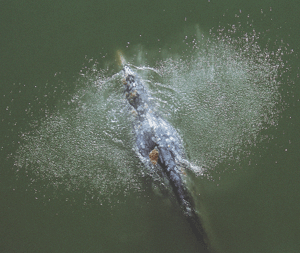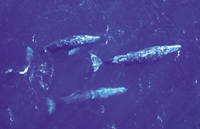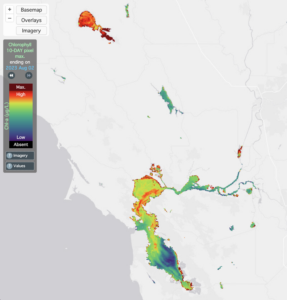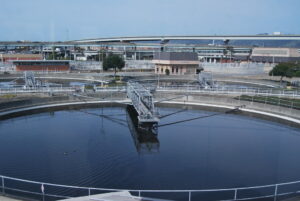Michael “Mik” Beatie, a senior vessel master for Golden Gate Ferry, has piloted a ferry between Larkspur and San Francisco for 26 years, and is well acquainted with the waters of central San Francisco Bay. One day in 1986, he saw something new. “I was towing one of the sailboats competing in the America’s Cup race. We were right off Raccoon Strait near Belvedere Point when I saw a barnacled rock directly in front of me.” Beatie tugs at his graying beard and laughs. “I wondered how a rock could be sticking out of the water at this depth. Then it arched and I saw its back. I tried to swerve, but it didn’t matter. The whale was gone.”
Beatie’s close encounter with a gray whale has become an increasingly common one in the Bay Area, posing a puzzle for scientists and a potential conundrum for environmentalists. Why are the whales here? Will they keep coming back? And if they do, can we ensure that the Bay—surrounded by cities and crisscrossed by bridges, ferries, and tankers—is a suitable haven for these large and magnificent mammals?
The Oceanic Society has been conducting whale-watching tours in the Pacific since 1974 and serves as the public’s clearinghouse for sightings of live whales within the Bay. Since the mid-1990s, the Society and the Marin-based Marine Mammal Center (which rescues and rehabilitates distressed seals, sea lions, sea otters, dolphins, and whales) have received an increasing number of calls from the public reporting gray whales inside the Bay.
“Three years ago, our former research director James Gilardi commuted by ferry and consulted with the skippers,” says Birgit Winning, executive director of the Oceanic Society. “Between his observations and anecdotal evidence from the public, we realized this phenomenon deserved a systematic study.” In 2000, the Society launched a five-year study, now over-seen by the organization’s current research director, Guy Oliver. The project’s initial phase has recently been completed. According to scientists, the sighted gray whales are definitely here on purpose, unlike Humphrey the Humpback Whale, who caused such a media sensation when he became stranded in the Bay back in 1984.
The gray whale is one of 80 species of cetaceans that range throughout the oceans of the world. It is a baleen whale, meaning that it ingests its food (benthic amphipods, tiny bottom-dwelling, tubelike creatures) by scooping mouthfuls of water and sediment and straining these through cartilaginous “teeth,” or baleen. Unlike other baleen whales in the north Pacific (humpbacks, blues, fins, sei, and minkes), the gray whale stays close to shore, preferring the relatively shallow waters along the coast.
- Gray whales migrating along the California coast. The whales willtravel up to 5,000 miles from their breeding grounds in Baja to feedinggrounds in the North Pacific. Photo by Barrie Rokeach.
Today, two populations of gray whales still exist. The eastern Pacific population (also known as the California stock) migrates from summer feeding grounds in the Bering, Chukchi, and western Beaufort Seas of Alaska to winter breeding grounds off the coast of Baja California. The western Pacific population (also known as the Korean stock) travels from the Sea of Okhotsk near Alaska to feeding grounds off Russia’s Sakhalin Island. The location of this population’s winter breeding and calving grounds is unknown, but reliable records point to an area off southern China. A third population of gray whales, hunted to extinction by the 18th century, is believed to have ranged between the coastal waters of Europe and Iceland and the eastern shore of North America.
The recovery of the eastern Pacific gray whale from the brink of extinction is one of the most rewarding stories of the modern conservation movement. In contrast, the Korean stock is estimated to be a “remnant population” numbering fewer than a hundred individuals. This population faces a serious threat to its habitat from plans by a consortium of oil companies (ExxonMobil and Royal Dutch/Shell) to construct a $22 billion oil- and gas-drilling facility on Sakhalin Island.
According to current genetic and paleontological research, modern cetaceans evolved from a land mammal that returned to the sea more than 60 million years ago. Using everything from artifacts and artwork and songs and stories to radio tags and DNA sampling, Pacific Rim cultures from prehistory to modern times have observed and documented the gray whale during its 10,000-plus-mile migratory journey.

- A whale surfaces directly below the Dumbarton Bridge, February, 2001. Photo by Alan Justice.
Yet there are very few historical reports of the gray whale—easily distinguished by its narrow, triangular head; mottled, broad fluke; and dorsal humps instead of fins—entering San Francisco Bay. Whereas 19th-century whalers reported that gray whales used San Diego Bay as a breeding lagoon (before abandoning it over 150 years ago due to increasing human settlement), there are few reports of them in San Francisco Bay. These whalers, who kept meticulous records, did not record any whale “takes” in the Bay. Guy Oliver cites one or two records by Spanish explorers that mention whale spouts in the Bay. And only one gray whale skeleton—dating back 2,500 years—has been unearthed from a Bay Area shellmound.
“If whales were historically common in the Bay, one would assume that the Ohlone Indians and others would have had whalebone artifacts,” Oliver says. “The lack of historical evidence has made it difficult for us to clarify whether the recent entrance of whales in the Bay marks their return to ancient feeding grounds or constitutes a wholly new occurrence.” It also leaves it unclear whether this recent rash of sightings will prove to be a unique event in response to a temporary change in the whales’ regular food supply, or whether the gray whales will be visiting on a regular basis. And if, in fact, they are here for the long term, can the Bay safely feed and support these visitors?
To find the answers, the Oceanic Society set up a hot-line telephone number asking the public to notify it when a whale was sighted (415-409-GRAY). Oliver, working with student volunteers, then went out to confirm the sightings. From 1999 through 2001, the survey found at least one gray whale in the Bay every month of the year except August, with the peak number of sightings taking place March through May, coinciding with the whale’s northbound migration.
“In the surveys, we found that gray whales are foraging, traveling, and milling about in the Bay,” says Oliver. “We have found all age classes, from calves of the year to mature whales. And we’ve sighted both individual whales and groups as large as five swimming together.”
The whales have been seen in many different parts of the Bay, from the waters off the Oakland Airport to the area between the Golden Gate and Treasure Island, as far east as the Carquinez Strait near the Benicia-Martinez Bridge, and as far south as the Dumbarton Bridge. (When a KCBS traffic helicopter announced a pod of whales frolicking beneath the Dumbarton in February 2001, it resulted in a major traffic jam.) According to Oliver, the whales especially like to swim in Raccoon Strait between Point Tiburon and Angel Island and in the area near the Sausalito sewage treatment plant.
“Now that we have proven they’re here, the next step is to find out how many and why,” says Oliver. “They seem to be coming to find supplemental foraging grounds, but confirming that involves a more thorough look at their food source and tracking the behavior of individual whales.” The Bay, as Oliver explains, is a very noisy place. Numerous studies document that whales — which depend on their acute hearing to navigate and stay in contact with each other — suffer when they encounter acoustic disturbances, such as those generated by large ship engines. If they are deliberately heading into such a heavily trafficked environment, there must be a compelling reason.
According to Oliver, the answer will be found through closer examination of gray whales’ eating habits. “The old dogma was that gray whales only ate during their four to six months at the northernmost feeding grounds. They would then make the southern migration at their fattest, give birth to calves in the warm-water lagoons of Baja, and return north with only the calves feeding on their mothers’ milk. This is not accurate for several reasons. First, not every whale makes the full migration.” Researchers are finding a small number of gray whales staying in places along the Pacific coast, such as Vancouver, Oregon, Humboldt County, and San Francisco Bay, rather than completing their migratory route. “Second, in terms of foraging, we are learning that gray whales are opportunistic,” Oliver adds. “They forage in mid-water for mysids, an invertebrate that swarms in great numbers. We have also seen them off the Channel Islands (in Southern California) foraging for fish right at the surface of the water. So, while the benthic resource in the Arctic probably makes up about 80 percent of their food, we don’t really know for certain their total diet.”
The question of food and its availability has led these researchers to investigate another anomalous trend for gray whales. “While we’re focused on the increased number of live whales in the Bay, there was also a two-year spike in the number of whale strandings,” Oliver says. “From 1999 to 2000, there were six times the number of dead whales washing up along the entire migratory route, with 300 reported by the National Marine Fisheries Service in 2000 alone.” In a normal year, fewer than a dozen whale strandings are reported along the California coastline, with only one or two of these occurring between Bodega Bay and Half Moon Bay. Because these numbers dropped back to “normal” in 2001, scientists are calling the strandings a “one-time mortality event.” Yet the great increase in both live and dead whales has created a puzzle scientists are anxious to solve.
Marine mammals that expire anywhere along the California coast between Mendocino and San Luis Obispo fall under the purview of The Marine Mammal Center, headquartered in the Marin Headlands. The group’s head veterinarian is Frances Gallund, a tall, youthful woman who has been with the center for eight years. From her office, Gulland can see migrating whales traveling past the Point Bonita Lighthouse and Black Sand Beach.
“We must note that during the 2001-2002 migration, whale strandings returned to the pre-die-off levels,” says Gulland. “However, the sharp increase of 1999-2000, in which 59 dead whales washed up in the Bay Area alone, was highly unusual. This die-off occurred during a six-week period between April and May when they were migrating north, when we can safely assume whales would be at their hungriest.” Gulland responded by organizing the California Whale Necropsy Team with UC Berkeley’s Museum of Invertebrate Biology, Moss Landing Marine Laboratories, UC Santa Cruz, and the Oceanic Society. Even with all this expert help, her attempts to study the causes of whale mortality were often thwarted. “It is extremely hard to examine a whale,” she explains. “We have a very short window, a few hours, really, to obtain fresh tissue samples before the corpse decomposes. After that, it’s useless.”
With all of these challenges, Gulland and her team were able to conduct necropsies on only two of the 59 stranded whales. Of those two, one clearly had died from propeller wounds and the other had domoic acid poisoning. “The final cause of death may have been a ship strike or tainted food in the Bay,” says Gulland. “But to my mind, these whales were dying of malnutrition. The real reason they were here to begin with is that they were starving.”
Although a scientific consensus will not emerge until researchers present their findings next December at the biennial meeting of the Society for Marine Mammalogy in Greensboro, South Carolina, Gulland’s hypothesis has garnered support among West Coast whale researchers. Dave Rugh, a wildlife biologist at the National Marine Mammal Lab in Seattle, is in charge of the biannual “abundance counts” of migrating whales at the Granite Canyon Research Station just south of Carmel. His team counted the largest population of gray whales to date — 26,000 — during the 1997-1998 southern migration. There was no census in 1999-2000, the year of the great die-off. But when the team returned to count in 2001-2002, it found the whale population had decreased sharply from the previous census. Rugh puts the current gray whale population at approximately 17,500. Research conducted by Wayne Perryman, a marine biologist at the Southwest Fisheries Science Center in La Jolla, adds another dimension to these findings. Perryman takes aerial photographs of migrating whales, measuring their size and shape to see if they’re healthy. “In 1999, the average whale was much thinner than usual,” he says. “Something was happening to affect their food source.”
Such evidence has led these scientists to postulate that the entrance of gray whales into the Bay, and the spike in strandings, were a one-time occurrence, linked to a catastrophic food shortage. A warm-water event during the late summer of 1998 in the Alaska Sea caused a massive die-off of benthic amphipods in shallow coastal waters, the whales’ primary food source. “The whales went south hungry and then came north dying,” says Rugh of the disastrous 1999-2000 migratory season. The staff of the Oceanic Society agrees that the 1999-2000 die-off and the increased presence of whales in the Bay are food related, but disagrees that the latter is temporary. “We believe it’s more than a one-time event,” says executive director Winning. “We’ve logged sightings on the Bay for many years, although certainly there was a large spike during the three-year period in question.”
“We are getting closer to hypothesizing why they’re here,” says Oliver. “We’ve had some sightings that tell us the animals are opportunistically feeding in the Bay. But we must prove that with more extensive observations.” Next March, he will be joined by a team from the National Geographic Society’s research and television arm that will install a “critter cam” on gray whales sighted in the Bay. At the same time, Oliver’s team will dive where whales are sighted, to examine the floor of the Bay for the presence of benthic amphipods. “If this food source exists here, we can safely assume they’ll be back,” says Oliver. Divers will be looking to see if the mats of interwoven tube worms, which float along the sandy bottom like a Persian carpet, show the telltale crescent-shaped scars left in the bottom sediment by feeding gray whales. They will also sample amphipods nearby to check for contaminants in the food source. Be-cause whales are bottom feeders, scientists are concerned about the heavy metals, such as arsenic and mercury, that were flushed into the Bay during the era of hydraulic gold mining and remain suspended in the bottommost sediments. “There is a chance,” says Oliver, “that this wonderful new feeding ground that the whales have discovered might not be in their best interest.”
A number of other factors could make the Bay a less than hospitable haven for returning whales. The San Francisco Bay Area Water Transit Authority is planning to increase the number of passenger ferries from 14 to 44 over a 10-year period from 2005 to 2015. Of those, 30 will be high-speed ferries traveling at 25 knots or more. What this means, according to Teri Shore of the Blue Water Network, is that even in the absence of a toxic or contaminated food source, whales could well be in danger of being struck and killed by high-speed vessels.
In addition, huge infrastructure projects, such as repair work on the Richmond Bridge, construction of the new eastern span of the Bay Bridge, and possible construction of new runways for the San Francisco International Airport, inevitably add traffic, pollutants, and noise to the Bay environment. The research being done now by Oliver, Gulland, and others could be an important first step toward consideration of mitigation measures for the whales.
For whatever reason, gray whales are now among us, giving us the unprecedented opportunity to see a spouting whale from Hunters Point or the bow of the Larkspur ferry. “In an environment so dominated by man, it’s great to see a little bit of wilderness return,” says Oliver. “That’s why, for me, the presence of the whales is a cause for celebration.”

.jpg)




